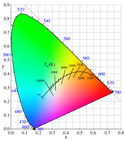Solar spectrum en
Relevante Bilder
Relevante Artikel
FarbtemperaturDie Farbtemperatur ist ein Maß zur quantitativen Beschreibung des Farbeindrucks von Lichtquellen. Als Referenz dient dabei das Spektrum eines idealen thermischen Strahlers, das allein von der Temperatur abhängig ist. Mit steigender Temperatur wechselt dessen Farbeindruck von Rot über Weiß bis ins Hellblau. Da rötliche Farben als „warm“ und bläuliche als „kühl“ empfunden werden, entspricht eine höhere Farbtemperatur einer „kühleren“ Farbe. Gebräuchliche Leuchtmittel haben Farbtemperaturen in den Größenordnungen von unter 3.300 Kelvin (Warmweiß), 3.300 bis 5.300 Kelvin (Neutralweiß) bis über 5.300 Kelvin (Tageslichtweiß). .. weiterlesen





